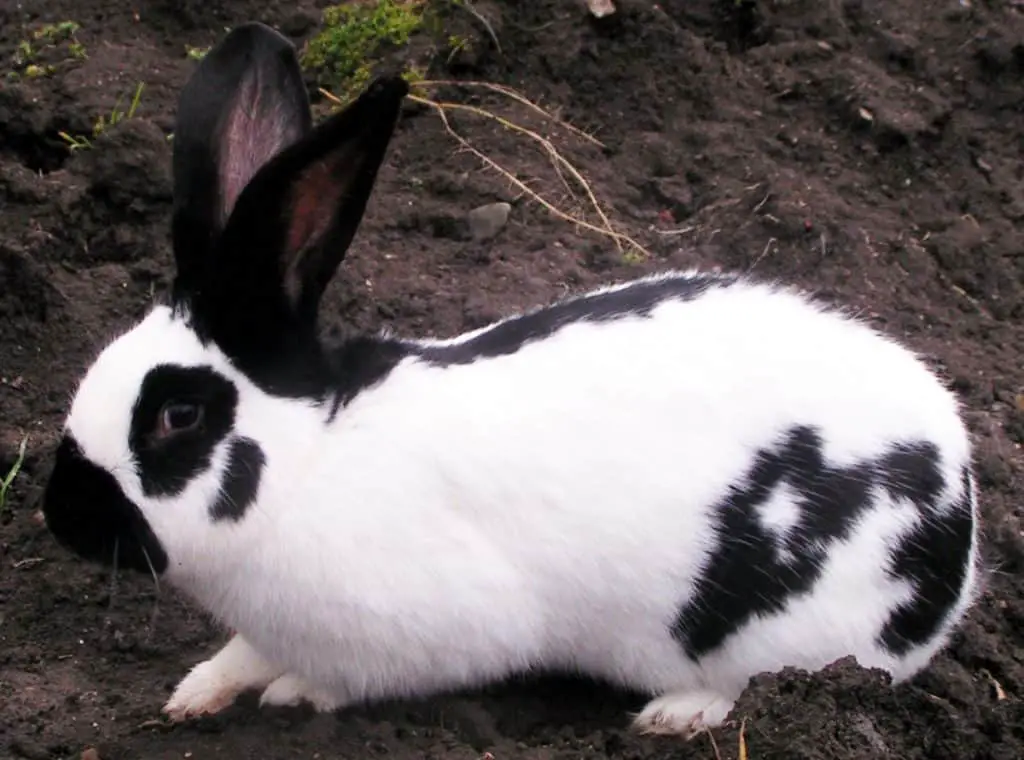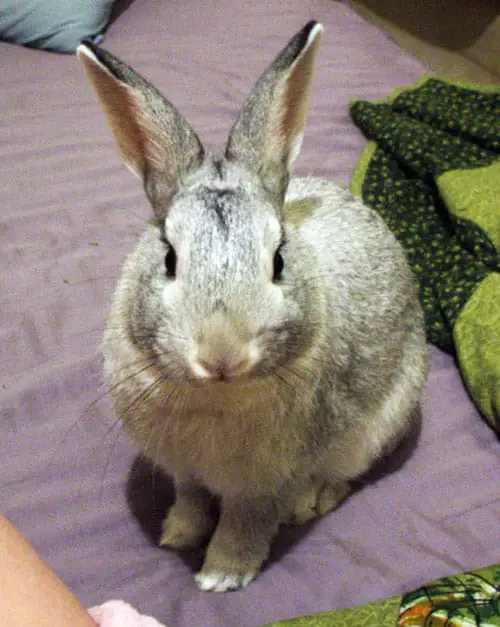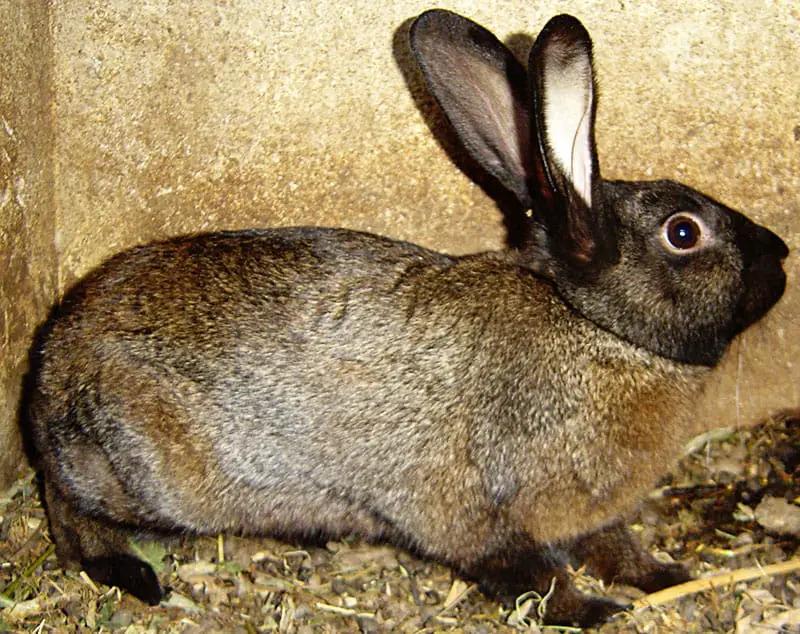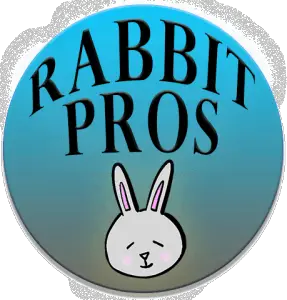Disclosure: We may earn money or products from the companies mentioned in this post.
We’ve discussed plenty of rabbit breeds here are Rabbit Pros; from the biggest rabbit breeds to the smartest, and we even have a list of the cuddliest bunny breeds. But that probably doesn’t surprise you, right? After all, we are the Rabbit Pros! Today we bring you a list of the 10 Rarest Rabbit Breeds.
This one is going to be fun, so let’s dig into the details.
Rare rabbit breeds might be hard to come by but not impossible. In this article, we discuss these exquisite breeds and the best places you can find these Rare Rabbit Breeds for Sale.
And we didn’t just make up a list of hard-to-find rabbits, instead, we looked to the experts at the Livestock Conservancy Organization and this list of rare bunnies comes from their 2020 annual reports. These good people are dedicated to the conservation of rare animal breeds, including rabbits. Let’s all tip our collective hats to their good work.
The rarity of rabbits affects both wild and domesticated breeds. Fortunately, there are organizations such as the Livestock Conservancy Organization that aim to protect livestock breeds and their population from dying out. This organization includes rabbits in their efforts as well as other kinds of livestock such as cattle, pigs, chickens, sheep, goats, and horses.
According to the Livestock Conservancy Organization, Rabbit breeds have separate parameters defined from how endangered they are. In this article, we will be discussing the different domestic breeds that fall under the Critical, Threatened, and Recovering categories.
Here are brief descriptions of each category of rare rabbits from the Livestock Conservancy Organization. You can get the complete descriptions here.
Critically threatened rabbit breeds have fewer than 200 annual registrations in the United States and an estimated global population of less than 500.
Threatened rabbit breeds are with fewer than 1,000 annual registrations in the United States and an estimated global population of less than 5,000.
Watch rabbit breeds are those that have lower populations or limited geographic distribution, with fewer than 2,500 annual registrations in the United States and an estimated global population of less than 10,000.
Recovering rabbit breeds are the near success stories of conservation. These are breeds that were once listed in another category but have exceeded watch category numbers. These are the wins!
List Of 10 Rarest Rabbit Breeds
Each of the following rare bunny breeds has been identified by the Livestock Conservancy Organization as threatened which means they are at risk of becoming extinct. As we discuss each breed, we’ll identify their level of risk.

1. Blanc De Hotot Rabbit
The Blanc De Hotot is identified as Critically Endangered.
This cute bunny traces its roots to a region in Normandy, France called Hotot-en-Auge. This region gives this cute and rate breed its unusual name.
Madame E. Bernhard takes all the credit for originating this breed by crossing numerous breeds. She had a specific idea of the perfect rabbit in mind, it must have a milky white coat and black eyes.
The first Blanc De Hotot made its debut in 1920 and was officially recognized as a breed in 1922. There are numerous times wherein the breed almost died out but rabbit enthusiasts from different parts of the globe never failed to see its beauty and have kept up the efforts to keep the breed alive.
This breed has distinct “eyeliners” which are dark rings around the rabbit’s eyes. They also have milky white fur that is described to look like frost. They have compact, thickset, and rounded bodies. The Blanc Hotot can weigh from 8 to 11 lbs and is part of the medium to the large category of rabbit breeds.
The Blanc De Hotot is one of the rarest breeds in the market today mainly because of its low population across the globe. This breed is considered friendly and sweet-natured. It is also considered to be an active breed and needs exercise to be happy and content.
For more information regarding this breed including an in-depth discussion of its history as well as a list of breeders then visit the Hotot Rabbit Breeders International organization. They can even help you find a Hotot Rabbit for sale.

2. Silver Rabbit
The Silver Rabbit is identified as Critically Endangered.
The Silver Rabbit is a rare breed only found in the United States and Canada. This breed is one of the oldest breeds of rabbits that exists. Its history is traced back as far as the 16th century In England. It is believed that Sir Walter Raleigh introduced the breed to England from Portugal.
It was imported to America in 1910 and was accepted by the American Rabbit Breeders Association (ARBA).
Silver rabbits have hard bodies with dense short coats. It has distinct ears that land vertically instead of the usual “V”. The pride and glory of this breed are its coats.
The Silver rabbit is known to have the densest flyback coat of all the rabbit breeds. Flyback coats mean that the rabbit’s fur will snap back into place when brushed. The guard hairs for the Silver are white and are intertwined with their coat colors (brown, black, and fawn) giving the breed its distinct silver sheen.
The Silver rabbit is a very active breed, it needs to be released from its cage regularly to ensure that it can release its pent-up energy and to avoid boredom that may lead to destructive behaviors such as chewing.
You can find more information about the Silver Rabbit at the National Silver Rabbit Club including help finding a SIlver Rabbit for sale.

3. Silver Marten Rabbit
The Silver Marten Rabbit is identified as Critically Endangered.
The Silver Marten Rabbit was previously described as “strange little black rabbits” back when they first appeared in the 1920s. Their existence is the result of breed experimentation when breeders wanted to improve the Chinchilla breed and started mixing black and tan rabbits into the mix.
The resulting breed was a breed so unique that it captured the attention of rabbit enthusiasts. This unique rabbit was then bred continuously and became known as the Silver Marten Rabbits of today.
The Silver Marten Rabbit is a small to medium-sized rabbit and can weigh from 6.5 up to 9 lbs. It also has ears that are vertically placed on their heads.
The coat of the silver martin is dark and luxurious on top and is white at the bottom. The intertwined dark color and white undercoat give the Silver Marten Rabbit its silver sheen.
The acceptable colors for the Silver Marten are black, sable, blue, and chocolate. It can also have markings on their bellies, underside of tails, nose, and eye circles.
This breed is known to be stubborn, so a bit of patience and consistency in training is needed from its owners. Socialization is also important to start at a young age.
You can find more information about this rare bunny at the Silver Marten Club where they can even help you find Silver Marten Rabbits for sale. If you want to deep dive into this breed, the Silver Marten Rabbit Guidebook.pdf provides in-depth information about the Silver Marten Rabbit breed.

4. Argente Brun Rabbit
The Argente Brun is identified as Threatened.
This is a rare and new breed that can be found in North America. However, the breed traces its roots back to Great Britain around 1940.
The breed was exported from one country to another, but it wasn’t until Ed White from Canada received one of the breeds and sold them to Charmain Wardrop of Washington was the breed was fully developed.
The breed was officially recognized and accepted by the American Rabbit Breeders Association (ARBA) in February 2016 making it one of the newer recognized rabbit breeds.
This breed is also one of the three Argente Breeds that are accepted by ARBA. It has a large body and can weigh from 8 to 10.5 lbs. once fully grown. It has a broad head and a unique mandolin-shaped body with ears that also stand vertically on its head.
The coat of the Argente Brun is soft and short. It has a chocolate undercoat, clear brown eyes, and different colored toenails. The coats of this breed are Blue, Brown, Champagne, Crème, and Black. This breed has an affectionate nature and is not averse to being handled by humans.
You can learn more about this bunny at the American Argente Brun Rabbit Club where they can even help you find Argente Brun Rabbits for sale.

5. Checkered Giant Rabbit
The Checkered Giant Rabbit is identified as Threatened.
The history of this breed is still a cause of some bunny lover arguments today. However, people seem to agree that its origins were in Europe when spotted rabbits, French Lops, and Flemish Giants were bred together. The breed came into the United States and was officially recognized in the 1900s.
As its name suggests, the Checkered Giant is one of the largest recognized breeds. It can grow up to 30 inches tall and can weigh up to 15 lbs. when fully grown.
This gentle giant has unique markings that make it endearing to bunny lovers. It can have white/black marking combinations and white/blue marking combinations. These markings can be found on the ears, noses, backs, and eye circles.
Checkered Giants can be standoffish but with quality time and care they will bond their owners. They are energetic, smart, and active. These are good pets for the elderly and families with older children.
For a full list of breeders that might have a Checkered Giant for sale, can visit the American Checkered Giant Club where you can also find more information about this rabbit breed.
6. Crème D’Argent Rabbit
The Crème D’Argent is identified as Threatened.
The Crème D’Argent is another of the three Argente breeds that are recognized by the American Rabbit Breeders Association. This is another breed whose history is a mystery for most people. It is believed to have originated from France. This breed came to America in 1924 and somehow became a fad.
After coming to America, its popularity grew rapidly as a production or meat rabbit, but then its popularity decreased just as fast. It is because of this that the breed almost went extinct.
It is a large breed of rabbits that are known for their white fur with an orange cast due to its orange undercoats. Full-grown rabbits of this breed can weigh from 8 to 11 lbs. Crème D’Argent is also noted for their great maternal instincts.
Crème de Argents have a sweet disposition, it is laid back and affectionate. It is also one of the recommended rabbit breeds for beginner pet owners.
If you want to learn more about this beautiful rare breed of rabbit, visit the Crème D’Argent Federation which works for the preservation of this breed and can help you find a Cream D’Argent rabbit for sale.

7. Standard Chinchilla Rabbit
The Standard Chinchilla Rabbit is identified as Threatened.
The Standard Chinchilla Rabbit is known to be one of the most affectionate rabbit breeds. It has a sweet disposition and loves receiving cuddles from its family. It loves to lounge on its owner’s laps and enjoy unlimited pets.
The Standard Chinchilla rabbit is the smallest breed out of the 3 Chinchilla rabbit breeds recognized by ARBA. The breed came from France and resembles a Chinchilla, a rodent that can be found in South America.
The standard chinchilla rabbit was first bred by Mr. M.J Dybowski and his first breed was dubbed the “Granddaddy of all Chins”.
The creation of the Standard Chinchilla was motivated by the demand for fur.
During the 1900s Chinchillas from South America were famous because they had exquisite furs that can be made into coats. However, Chinchillas only produce a small litter and because of that they simply could not supply the demand for more coats.
Hence, the Standard Chinchilla was born. Not only did the Standard Chinchilla have a coat like that of their smaller Southern American cousins, but their coats were less expensive.
The Standard Chinchilla is a medium-sized rabbit and can weigh up to 7.5 lbs when mature.
Its coat is a blend of tan, brown, and chestnut mixed in with blue, black, and white. It also has white bands around its eyes which makes them distinct from the other Chinchilla breeds.
In its early days, the popularity of the Standard Chinchilla Rabbit Breed was tied to the demand for their fur. But when the demand for fur died down so did this breed’s popularity which leads to their declining numbers.
To learn more about this stunning bunny breed, you might refer to the American Standard Chinchilla Rabbit Breeders Association which is dedicated to preserving this rare bunny breed. They can also help you find Standard Chinchilla Rabbit for sale.

8. Belgian Hare Rabbit
The Belgian Hare has been identified as Recovering from being threatened.
The Belgian Hare is a beautiful breed that might be singularly responsible for the massive popularity of domestic rabbits being raised for meat in the United States.
This is a crazy story, so just hang on for the ride…
In the 18th century, rabbit breeders in Belgium tried to create a meat rabbit by crossbreeding a very early domestic rabbit to wild European hares. What they came up with was a pretty rabbit, but was pretty lanky like their wild rabbit ancestors.
Still, the rabbit was domesticated and found its way to England in the early 1800s, where the English begin to refer to it as the Belgian Hare.
The first Belgian Hares arrived in American in 1877 and soon become a wildly popular show and meat rabbits. Their popularity spawned some of the first rabbit clubs in America and what is referred to as the “Belgian Hare Boom” which meant there were Belgian Hares everywhere.
It really did seem like everyone had a breeding pair of Belgian Hares in their backyard while others were investing fortunes in these rabbits in hopes of feeding a growing America with a new protein source.
Reports claim that in the early 1900s there were over sixty thousand Belgian Hares in Los Angeles County alone! Can you imagine how many were in America? There are also reports that a single spectacular male Belgian Hare sold for $5,000 in 1900!!!!
However, there was one big problem, while the Belgian Hare is a fine fancy rabbit, it doesn’t have much meat on it.
By the 1940s the Belgian Hare was replaced with much better production rabbits which were larger and meatier. Soon these popular rabbits were left to history as they were replaced by production rabbits like the New Zealand White, Californian, and American Rabbit.
With that, this once crazy popular rabbit has become rare and even endangered, though it’s recovering now but not as a meat rabbit but as an amazing pet rabbit.
The Belgian Hare is a result of selective breeding to give them the physical characteristics like those of a Hare (the wild European rabbit) instead of the characteristics of most other domestic rabbits. It has long limbs and a lanky lean appearance. Its coat is a rich reddish color.
They are medium-sized rabbits and can weigh from 6 to 9 lbs.
Belgian Hares are intelligent and active, however, they also have the reputation of being skittish like their wild ancestors. They are therefore recommended as pets for seniors and families with older children.
Belgian Hares do relatively well in any climate, however, avoid taking this breed of rabbit out for exercise when it is extremely hot or humid outside.
A full guide for Belgian Hare ownership is offered both by the British Belgian Hare Club and the American Belgian Hare Club. In addition, both clubs can help you find Belgian Hares for sale.

9. Beveren Rabbit
The Beveren Rabbit has been identified as Recovering from being threatened.
The Beveren Rabbit got its name from its origin however, there are some contentions regarding this information. Most rabbit lovers believe that the Beveren Rabbit originated from the town of Beveren, Belgium, and was originally called the “Blue Rabbit of Beveren”.
However, others claim that the breed came from England probably because it was first shown in England in the early 1900s.
Regardless of its geographical origin, almost everyone agrees that the breed is a result of crossbreeding Brabanconne, St. Nicholas Blue, and Blue Vienna rabbit breeds.
The Beveren Rabbit is a large breed of rabbit that can weigh 8-12 lbs. It also has a mandolin-shaped body. They have three distinct coat colors namely: blue, black, and blue-eyed white. The coat color of this breed should be uniform and solid throughout its body.
This docile breed is currently being imported continuously to the United States to grow the US population while avoiding problems that can be caused by inbreeding. We hope that this rabbit population continues to rise.
To learn more about this breed and to find Beveren Rabbits for sale visit the American Beveren Rabbit Club.

10. Silver Fox Rabbit
The Silver Fox Rabbit has been identified as Recovering from being threatened.
The Silver Fox is a large breed of rabbit that got its name because of the striking resemblance of its fur to the wild fox who also shares the same name.
This is one of the oldest breeds of rabbits. It was first recognized by the American Rabbit Breeders association in 1925.
The unique traits of this breed are its long fur and silvered coat. It has silver-tipped furs that can be found all along its body. The coat of the Silver Fox is coarse like a fox.
A full-grown Silver fox can weigh from 9 to 12 lbs. They have a medium-length body and strong hindquarters and shoulders.
The Silver Fox is also the only rabbit breed with “stand-up fur”. This means that its fur will not remain in place when brushed, unlike other rabbit breeds whose furs snap back into place when brushed against the grain (fly-back fur).
The Silver Fox comes in a variety of colors such as black, blue, and chocolate. However, only the black Silver Fox is considered by the American Rabbit Breeders Association.
To learn more about this beautiful breed of rabbit, visit the National Silver Fox Rabbit Club. They are an excellent club and also might be able to help you find a Silver Fox Rabbit for sale near you.
_______
Truly, owning a pet rabbit is rewarding but owning a rare breed is even more so.
We sincerely hope that with this article we have both captured your imagination while educating you about these exquisite yet elusive bunnies.
Do you have experience caring for any of these rare breeds? Share your story in our comment box below.
Do you raise a rare breed of rabbits? Then signup for our email list and drop us an email with information about your breeding program. Who knows, we might even do an article about your rare rabbits!
~Stacey
